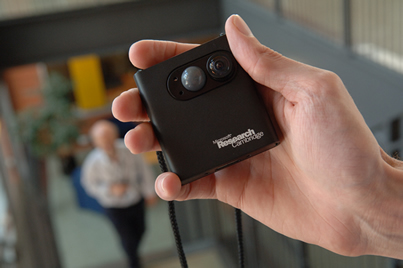 A camera originally invented to help jog the memories of people with Alzheimer’s disease will soon be launched by a UK-based firm. Microsoft Research’s innovative SenseCam technology can help people who have suffered from memory loss by enabling them to recall previously inaccessible memories. SenseCam is a wearable digital camera that is designed to take photographs passively, without user intervention, while it is being worn. Unlike a regular digital camera or a cameraphone, SenseCam does not have a viewfinder or a display that can be used to frame photos. Instead, it is fitted with a wide-angle (fish-eye) lens that maximizes its field-of-view. This ensures that nearly everything in the wearer’s view is captured by the camera, which is important because a regular wearable camera would likely produce many uninteresting images.
A camera originally invented to help jog the memories of people with Alzheimer’s disease will soon be launched by a UK-based firm. Microsoft Research’s innovative SenseCam technology can help people who have suffered from memory loss by enabling them to recall previously inaccessible memories. SenseCam is a wearable digital camera that is designed to take photographs passively, without user intervention, while it is being worn. Unlike a regular digital camera or a cameraphone, SenseCam does not have a viewfinder or a display that can be used to frame photos. Instead, it is fitted with a wide-angle (fish-eye) lens that maximizes its field-of-view. This ensures that nearly everything in the wearer’s view is captured by the camera, which is important because a regular wearable camera would likely produce many uninteresting images.
There are very few aids that complement autobiographical memory, i.e. support the remembrance of things done or experienced. No other device, tool or method has been as effective as SenseCam on people who ordinarily would forget a significant, meaningful event within days of it happening
Emma Berry, Neuropsychologist, Addenbrookes’ Hospital, Cambridge, UK
“Not only does it allow people to recall memories while they are looking at the images, which in itself is wonderful,” says Berry, who now works with Georgina Browne to further research on the technology, “but after an initial period of consolidation, it appears to lead to long-term retention of memories over many months, without the need to view the images repeatedly.
“This is astonishing, given that the same people would ordinarily forget a significant, meaningful event within days of it happening. There is no other device, tool, or method that has the same effect. No wonder the memory community is so excited about this.”
